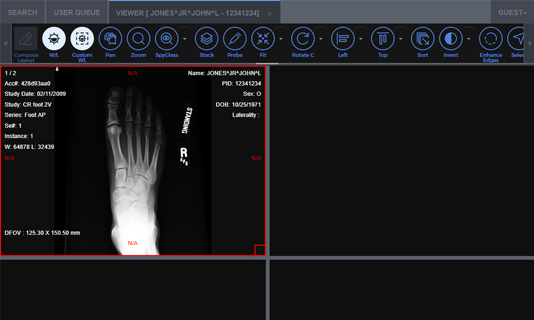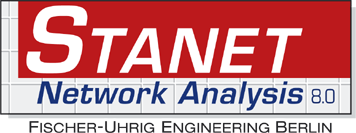DICOM Communication SDK Libraries
The LEADTOOLS DICOM Communication SDK library provides .NET Framework, .NET MAUI, Xamarin, C++ Class Library, C#, VB, C/C++, Objective-C, and Swift developers with high-level communications components that simplify the creation of DICOM client/server applications, such as PACS, with complete implementations for all DICOM service classes such as Verification, Query/Retrieve, Storage, and Patient Management.

Robust DICOM Communication Libraries
With the DICOM Communication SDK library, developers can create unified and seamless solutions by adding DICOM communications to their applications and creating middleware to connect disparate devices, applications, and PACS systems. The LEADTOOLS DICOM Communications libraries include the following features:
- Complete support for Message Exchange, including DIMSE (DICOM Message Service Element) service users and providers, and Message Exchange Upper Layer Protocol
- Multiple clients and servers via asynchronous or synchronous TCP/IP connections
- High-level functions that initiate and terminate associations, thereby automating the filling of PDU structures
- Automatic and transparent conversion between specific transfer syntaxes required by the associated application entities
- High-level functions and components automate DICOM Request and Response command sets, greatly simplify the addition of DICOM communication to your application
- High-level DICOM Print library
- Secure data transmission with TLS and ISCL security profiles
- Designed to make it easy to keep encryption in your application up to date and change as the DICOM standard changes
- Use IPv4 and IPv6 addressing
- Low-level functions to customize network sockets

DICOM Communication SDK Opens the Door
The LEADTOOLS DICOM Communications library APIs provide the framework and functions to:
- Open and initialize a DICOM network connection
- Create a DICOM Associate Connection to transfer data and messages
- Customize the DICOM Associate Connection for data and transfer types
- Retrieve information about the DICOM Associate Connection
- Retrieve information about the DICOM Network Connection
- Send and receive messages using either the high-level or low-level functions
Create consumers and providers for any DICOM service class, including:
- Basic Worklist Management
- Media Storage
- Patient Management
- Print Management
- Queue Management
- Query/Retrieve
- Storage Commitment
- Storage Service
- Study Content Notification
- Study Management
- Verification
- Results Management
- Any DICOM Message Service Element (DIMSE)
Create DIMSE-C services associated with composite SOP classes:
- C Cancel Request/Response
- C Echo Request/Response
- C Find Request/Response
- C Get Request/Response
- C Move Request/Response
- C Store Request/Response
Create DIMSE-N services associated with normalized SOP Classes and provide an extended set of operations and notifications:
- N Action Request/Response
- N Create Request/Response
- N Delete Request/Response
- N Event Report Request/Response
- N Get Request/Response
- N Set Request/Response
AE's can serve in one of two roles:
- Invoke a DIMSE-service-user (SCU)
- Perform a DIMSE-service-user (SCP)

Leading WADO and DICOMWeb APIs
LEADTOOLS libraries provide extensive support for DICOM WADO, including WADO-URI, WADO-WS, and DICOMweb (RESTful DICOM Services). Developers can use the API to directly access patient/study related data stored in third-party PACS or expose PACS data to direct third-party access using the DICOM defined HTTP protocol standard, including DICOM data storage (STOW-RS) over the web.
- Access DICOM persistent objects (through HTTP/HTTPS protocol) using DICOM UIDs (Unique Identifiers)
- Retrieve data in presentation-ready form such as JPEG and GIF (according to PS3.18 2017b) or native DICOM format
- ASP.NET source code and examples are included for easy customization
DICOMweb and WADO services are solutions to real-world problems such as:
- Reference an image or report from an electronic patient record (EPR)
- Reference an image in an email
- Provide access of images, reports, and waveforms to outside physicians and hospitals
- Provide anonymized DICOM reports, images, and waveforms for teaching and clinical trials

Easy to Integrate
LEADTOOLS handles the heavy lifting, eliminating months of R&D, while giving you the best quality and performance available. You'll be free to focus on other components of your application. Download the LEADTOOLS evaluation to streamline your development.

DICOM Communication SDK Platforms and Programming Interfaces
Operating Systems
Projects that use LEADTOOLS DICOM Communication libraries can be deployed to Windows, Linux, macOS, Android, and iOS devices.
Frameworks
Developers that are leveraging these frameworks can utilize the DICOM Communication SDK: .NET Framework, .NET MAUI, Xamarin, WinForms, C++ Class Library, and ASP.NET
Programming, Scripting, Markup
DICOM Communication code snippets and demo applications are provided for the following: C#, VB, XAML, C/C++, Objective-C, and Swift
Start Coding with LEADTOOLS DICOM Communication
DICOM Communication libraries as well as all LEADTOOLS Recognition, Document, Medical, Vector, and Imaging technologies for all development and target platforms, including Windows, Linux, and macOS.
Online Demo Application that include DICOM Communication SDK Libraries
HTML5/JavaScript Medical Web Viewer Framework
A zero-footprint Medical viewer with light and dark themes to display DICOM images (pixel data) with window level, density removal, offset, scale, zoom, stack, annotation/markup, and multi-touch support for phone, tablet, and desktop.
It demonstrates zero-footprint 3D volume rendering of multiple volume types including VRT, MIP, MPR, and SSD in the Medical Web Viewer. The viewer does not require browser plugins, desktop utilities, or remote desktop clients and options for low-resolution and caching to speed up rendering and loading.
Note: If you have your own test images that you would like to upload into the application, contact [email protected] to have a private user profile created.










